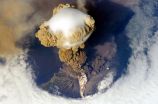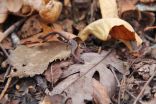(Press-News.org) WASHINGTON, DC-- Small volcanic eruptions might eject more of an atmosphere-cooling gas into Earth's upper atmosphere than previously thought, potentially contributing to the recent slowdown in global warming, according to a new study.
Scientists have long known that volcanoes can cool the atmosphere, mainly by means of sulfur dioxide gas that eruptions expel. Droplets of sulfuric acid that form when the gas combines with oxygen in the upper atmosphere can remain for many months, reflecting sunlight away from Earth and lowering temperatures. However, previous research had suggested that relatively minor eruptions--those in the lower half of a scale used to rate volcano "explosivity"--do not contribute much to this cooling phenomenon.
Now, new ground-, air- and satellite measurements show that small volcanic eruptions that occurred between 2000 and 2013 have deflected almost double the amount of solar radiation previously estimated. By knocking incoming solar energy back out into space, sulfuric acid particles from these recent eruptions could be responsible for decreasing global temperatures by 0.05 to 0.12 degrees Celsius (0.09 to 0.22 degrees Fahrenheit) since 2000, according to the new study accepted to Geophysical Research Letters, a journal of the American Geophysical Union.
These new data could help to explain why increases in global temperatures have slowed over the past 15 years, a period dubbed the 'global warming hiatus,' according to the study's authors.
The warmest year on record is 1998. After that, the steep climb in global temperatures observed over the 20th century appeared to level off. Scientists previously suggested that weak solar activity or heat uptake by the oceans could be responsible for this lull in temperature increases, but only recently have they thought minor volcanic eruptions might be a factor.
Climate projections typically don't include the effect of volcanic eruptions, as these events are nearly impossible to predict, according to Alan Robock, a climatologist at Rutgers University in New Brunswick, N.J., who was not involved in the study. Only large eruptions on the scale of the cataclysmic 1991 Mount Pinatubo eruption in the Philippines, which ejected an estimated 20 million metric tons (44 billion pounds) of sulfur, were thought to impact global climate. But according to David Ridley, an atmospheric scientist at the Massachusetts Institute of Technology in Cambridge and lead author of the new study, classic climate models weren't adding up.
"The prediction of global temperature from the [latest] models indicated continuing strong warming post-2000, when in reality the rate of warming has slowed," said Ridley. That meant to him that a piece of the puzzle was missing, and he found it at the intersection of two atmospheric layers, the stratosphere and the troposphere-- the lowest layer of the atmosphere, where all weather takes place. Those layers meet between 10 and 15 kilometers (six to nine miles) above the Earth.
Traditionally, scientists have used satellites to measure sulfuric acid droplets and other fine, suspended particles, or aerosols, that erupting volcanoes spew into the stratosphere. But ordinary water-vapor clouds in the troposphere can foil data collection below 15 km, Ridley said. "The satellite data does a great job of monitoring the particles above 15 km, which is fine in the tropics. However, towards the poles we are missing more and more of the particles residing in the lower stratosphere that can reach down to 10 km."
To get around this, the new study combined observations from ground-, air- and space-based instruments to better observe aerosols in the lower portion of the stratosphere.
Four lidar systems measured laser light bouncing off aerosols to estimate the particles' stratospheric concentrations, while a balloon-borne particle counter and satellite datasets provided cross-checks on the lidar measurements. A global network of ground-based sun-photometers, called AERONET, also detected aerosols by measuring the intensity of sunlight reaching the instruments. Together, these observing systems provided a more complete picture of the total amount of aerosols in the stratosphere, according to the study authors.
Including these new observations in a simple climate model, the researchers found that volcanic eruptions reduced the incoming solar power by -0.19 ± 0.09 watts of sunlight per square meter of the Earth's surface during the 'global warming hiatus', enough to lower global surface temperatures by 0.05 to 0.12 degrees Celsius (0.09 to 0.22 degrees Fahrenheit). By contrast, other studies have shown that the 1991 Mount Pinatubo eruption warded off about three to five watts per square meter at its peak, but tapered off to background levels in the years following the eruption. The shading from Pinatubo corresponded to a global temperature drop of 0.5 degrees Celsius (0.9 degrees Fahrenheit).
Robock said the new research provides evidence that there may be more aerosols in the atmosphere than previously thought. "This is part of the story about what has been driving climate change for the past 15 years," he said. "It's the best analysis we've had of the effects of a lot of small volcanic eruptions on climate."
Ridley said he hopes the new data will make their way into climate models and help explain some of the inconsistencies that climate scientists have noted between the models and what is being observed.
Robock cautioned, however, that the ground-based AERONET instruments that the researchers used were developed to measure aerosols in the troposphere, not the stratosphere. To build the best climate models, he said, a more robust monitoring system for stratospheric aerosols will need to be developed.
INFORMATION:
EUGENE, Ore. -- Nov. 18, 2014 -- Leave it to long-dead short-tailed shrew and flying squirrels to outfox climate-modelers trying to predict future habitats.
Evidence from the fossil record shows that gluttonous insect-eating shrew didn't live where a species distribution technique drawn by biologists put it 20,000 years ago to survive the reach of glaciers, says University of Oregon geologist Edward B. Davis. The shrew is not alone.
According to a new study by Davis and colleagues, fossil records of five ancient mammalian species that survived North America's last glacial ...
Hamilton, ON (Nov. 18, 2014) - McMaster University researchers have found new evidence that suggests patients with a history of adverse reaction to the blood thinner heparin may be ready for urgent heart surgery sooner with a combination of appropriate blood screenings and therapeutic plasma exchange.
The study was published online today in Blood, the journal of the American Society of Hematology. The lead author is Dr. Theodore Warkentin, a professor in the Department of Medicine's Division of Hematology and Thromboembolism and the Department of Pathology and Molecular ...
The consumption of a diet high in fructose throughout adolescence can worsen depressive- and anxiety-like behavior and alter how the brain responds to stress, according to new animal research scheduled for presentation at Neuroscience 2014, the annual meeting of the Society for Neuroscience and the world's largest source of emerging news about brain science and health.
"Our results offer new insights into the ways in which diet can alter brain health and may lead to important implications for adolescent nutrition and development," said lead author Constance Harrell of ...
Washington, D.C. - November 18, 2014 - Lumosity is presenting new research today at the 2014 Society for Neuroscience conference on how altering cognitive task parameters affects learning rates. The study, titled "Optimizing Cognitive Task Designs to Improve Learning Rates in a Large Online Population," analyzed game play performance from 99,022 participants, and found that participants operating closer to their performance threshold earlier in their experience with a cognitive task tend to have faster learning rates - especially at higher levels of difficulty.
"By looking ...
Ticagrelor halves risks of stents blocking with blood clots
Study of 18,000 patients shows cost-effective drug could prevent premature deaths
Reduces the risk of patients needing repeat operations
Treating heart attack patients with ticagrelor reduces the risk of stents blocking with blood clots according to a ground breaking new study conducted by researchers from the University of Sheffield.
The new findings confirm that treating heart attack patients with the pioneering drug ticagrelor, instead of the previous standard treatment clopidogrel, could halve the risks ...
COLUMBIA, Mo. - In the 1970s, ecologists published results from one of the first whole-forest ecosystem studies ever conducted in Hubbard Brook, New Hampshire. In the paper, scientists reported that salamanders represent one of the largest sources of biomass, or food, of all vertebrates in the forest landscape. Now, using new sampling and statistical techniques not available during the past study, researchers at the University of Missouri have estimated that the population of salamanders in forested regions of the Missouri Ozarks are 2-4 times higher than originally thought, ...
NEW YORK (November 18, 2014) - The addition of mitral valve (MV) repair (a valve of the heart) to coronary artery bypass grafting (CABG), a type of open-heart surgery, did not result in significant benefit to the patient and was associated with increased risk of neurological events. Therefore, the routine addition of MV repair to CABG in patients with moderate IMR did not demonstrate a clinically meaningful advantage.
The Cardiothoracic Surgical Trials Network (CTSN) is reporting results for the first time from a clinical trial of patients who have a complication of ...
Over the last decade, neuroscientists have largely come to believe that physical pain and social pain are processed by the brain in the same way. But a new study led by the University of Colorado shows that the two kinds of pain actually use distinct neural circuits, a finding that could lead to more targeted treatments and a better understanding of how the two kinds of pain interact.
For the study, published in the journal Nature Communications, the researchers used a technique recently borrowed from the computer science field by neuroscientists--multivariate pattern ...
WASHINGTON D.C., November 18, 2014 - On a quest to design an alternative to the two complex approaches currently used to produce electrons within microwave electron guns, a team of researchers from Euclid TechLabs and Argonne National Laboratory's Center for Nanoscale Materials have demonstrated a plug-and-play solution capable of operating in this high-electric-field environment with a high-quality electron beam.
Unfamiliar with microwave electron guns? Perhaps best known within the realm of X-ray sources, microwave electron guns provide a higher current and much higher ...
Medications, such as chemotherapy, are often limited by their tendency to be detrimental to healthy cells as an unintended side effect. Now research in the November 18th issue of Cell Press's Biophysical Journal offers a new computational model that can help investigators design ways to direct drugs to their specific targets.
A major problem with many cancer drugs is the harmful effects they can have on normal cells. Similarly, treatments for a variety of other diseases can have side effects by acting on cells that are not meant to be targeted. Researchers have tried ...



